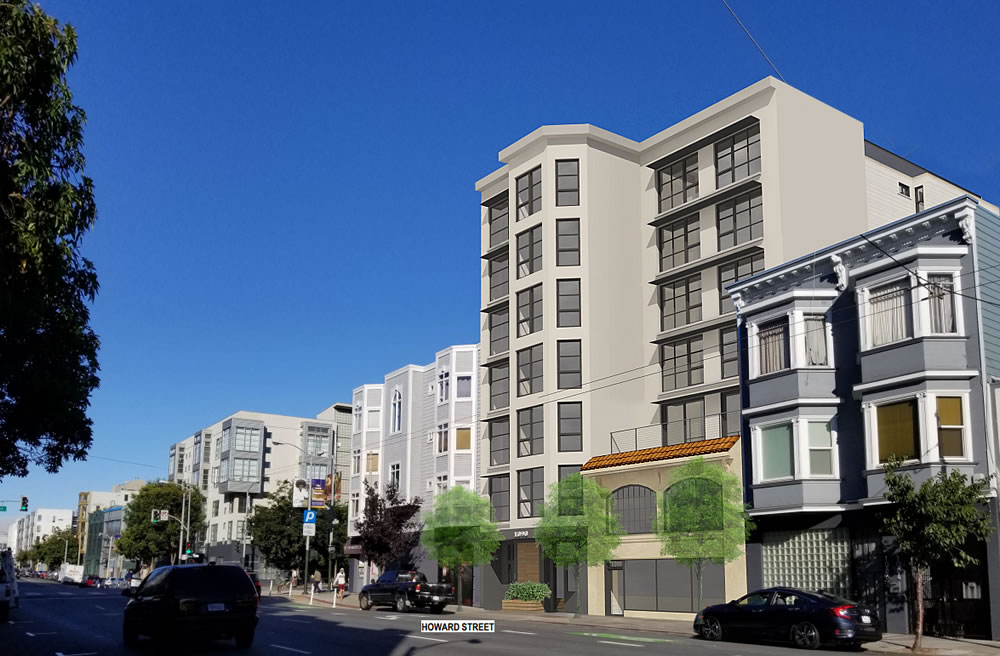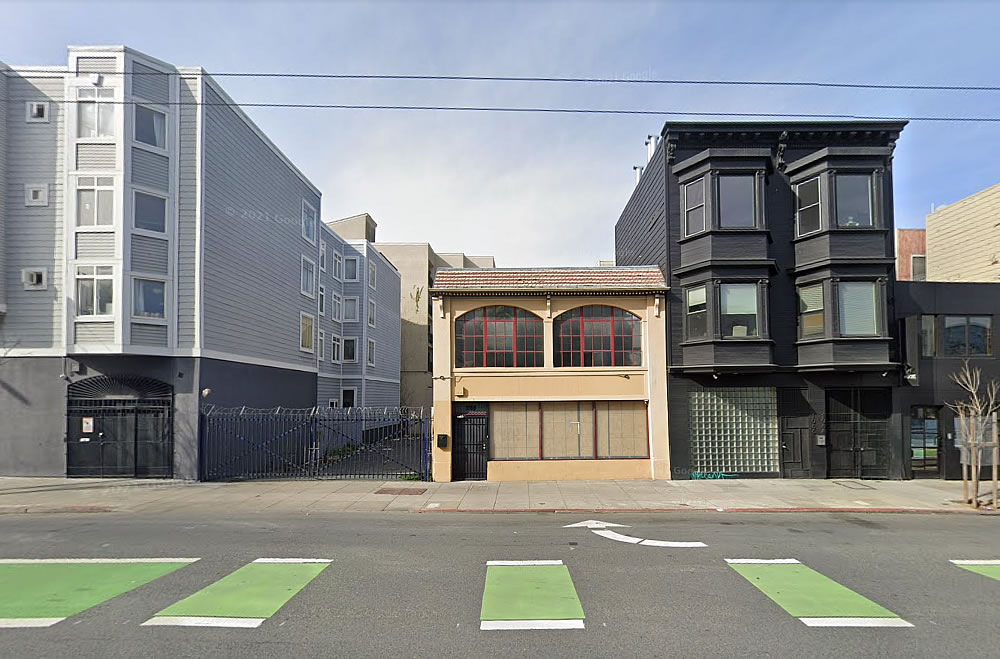Redesigned to yield 24 two-bedroom units, rather than a mix of 12 one-bedrooms and 12 twos, building permits for the approved seven-story development to rise adjacent to and behind the façade of the historic City Paints building at 1088 Howard Street, which is to be preserved, along with 2,600 square feet of new ground floor retail space, were approved, paid for and issued this past April.
The ground for the fully approved and permitted project has yet to be broken, however. And in fact, the plans, permits and Western SoMa parcel, which was acquired for $3.1 million back in April of 2019, prior to the project being entitled, are now on the market with a $4.95 million price tag.


Isn’t this standard SF practice, in which the firms that specialize in project entitlement are different than the firms that specialize in building? What makes you think the buyer of the entitled project won’t break ground soon?
Great owner user building with the side yard. Going to be challenging with the City leasing a drug rehab facility at 1076 howard for the next 10 or 15 years.
How long before the block gets covered spray paint? I mean San Francisco democratic expression at it’s finest.
3…2….1 property trades for 750k less then it was purchased for in 2019.
You’re telling me that buildings in the city are at risk of graffiti? How will we ever survive?! I’d clutch my pearls but I think I left them in the burbs…
You know why the word graffiti is latin? Because this complaint has been true in every city since before gladiator fights.
this is more then just your occasional “graffiti”: Graffiti Mob Targeting San Francisco Mission District Businesses
Oh no! Not paint! Whatever shall we do?!?!?!?!?!?!
Put them in stocks in the center of town…
Fair enough. I figure a lot of people would be more than happy to return to the gladiator days: Ban the retail sales of spray paint and control/license it wholesale and have taggers work out of a box of chalk like in the olden days.
“Ban the retail sales of spray paint and control/license it”
I had to come back to comment because I can’t stop thinking about just how ludicrous this comment is. You have somehow come up with a policy that simultaneously over the top authoritarian by banning basic art/home-improvement supplies while being completely toothless and impossible to enforce since anyone can just buy this stuff online or in another city. Go outside and touch some grass man. This is up there with the guy who regretted the city never built the highway over The Panhandle! lol
It’s been done for vapes
Stories like this suggest to me that however much San Francisco rents have dropped from pre-Covid highs, they will continue to move back up.
We won’t have enough new supply of housing in the foreseeable future to keep rents down.
There were an interesting couple of Freakonomics podcasts recently about how and why so many Americans are moving to Dallas (spoiler: cost of living and affordable places to live without crime).
Without crime…really??
Even for a hyperboless that generalization seems rather careless https://www.city-data.com/crime/crime-Dallas-Texas.html
Why, that’s less than triple SF’s murder rate!
You guys haven’t moved much apparently.
It’s easier to find affordable neighborhoods without substantial crime in the Dallas area. You don’t move into a statistical aggregate – you pick a street address.
But don’t take my word for it – check out Freakonomics.
No thanks, I was less-than-impressed last time I checked. But let’s back back to your premise:
(rents) will continue to move back up. We won’t have enough new supply of housing in the foreseeable future to keep rents down.
And so to bolster your argument that demand will remain high in this expensive, dangerous place you mention that people like to move to “affordable places to live without crime”…your words – or somebody’s anyway – not mine.
Not that I’m saying you’re wrong, mind you, only that you seem to be trying hard to look like it.
Rents in San Francisco will continue to move up because people still want to live and work here. It’s February 9th, clear, sunny, and warm today in the city. The parts of California and San Francisco that have always made living here nice are unchanged, even if Covid and WFH have changed living patterns. My personal anecdote here is that I just finished leasing up a small remodeled building on the West side of town. Half my applicants/prospects were pre-child couples moving BACK to the city after a year of work from anywhere, or a year in Marin, or a year in San Jose etc.. Those places evidently lost luster for young people. The other prospects were people moving within the city for a better deal. That intra-city move dynamic exists but is tailing off.
I think rents will continue to climb in part because it is difficult and expensive to build new housing in San Francisco. If we imagine the 24 proposed units average 700sf each plus 2400 of retail, that’s 19,200sf of finished space, ignoring circulation etc.. Could one build a building this tall for $750psf? I don’t know. $750* 19,200 = $14,400,000 construction cost + $4,950,000 land cost = $19.35mm = $775,000 per door counting the retail (which everyone wants) the same as the apartment units. I don’t think this lot will be sold near the asking price or the project developed. Even as expensive as our rents and costs are, developers can’t afford to build housing to meet demand aside from moneyed young tech workers and wealthy newcomers. The new arrivals will continue to drive up rents.
SF lost population during the first part of the pandemic. I suggest that trend will not continue.
At the same time, Dallas (and the suburban metro area North of Dallas) has experienced tremendous population growth over the past decade. South Dallas is crime-ridden and has poor schools, but of course that is not where people are moving. People are moving to new homes in the areas outside of South Dallas where it is easy to build new homes, and therefore new homes are being built.
My point isn’t that people are choosing Dallas over San Francisco as a binary, it’s more that SF does a great job of making newcomers unwelcome in economic terms, and so SF are less apt to grow as a city in population terms as Dallas is doing.
San Francisco will continue to attract wealthy and ambitious newcomers (because there are still lots of great things about the city) and follow policies that drive out middle class people and the unenfranchised poor.
Talking about driving out the middle class!
The people behind this project (architect /owners) along with the SF Planning Dept and Matt Haney had no interest in the fact that their poorly designed building would have a detrimental effect on the affordable housing next door.
I am an owner next door and fought the design asking for a minimal light/air well to just equal ours (there are 10 units affected) and to keep my lot line window from being covered up allowing at least a reasonable light and airflow to my modest (aka affordable) home. I hope it is never built as designed/approved.
Notcom, what you should be reading that as is a hope, or a prayer.
The hope that in spite of people moving from The Bay Area to a metro area inside of a state which is mostly a flat prairie in order to avoid overpaying for housing, rents will continue to move up in order to support ever increasing housing costs and associated outsized returns to real estate investment in S.F., which will in turn support increasing commissions on real estates sales.
I guess the implicit prediction here is that housing supply in S.F. will contract at a rate higher than the rate at which people flee high housing costs here to outlying states (so that prices don’t move lower), which would in turn explain the knee-jerk defenses of dwelling unit mergers here.
so that prices don’t move lower
Ah yes: in six words exposing the utter disingenuous – or is it utter cluelessness? – of the build! more! affordability! crowd…that we can somehow create new housing that’s cheaper than what’s here now, yet somehow avoid depressing the price of what’s here now (and more to the point, owned by people who have no desire to see that happen).
I don’t know about real estate commissions – that’s not my area.
I do think that San Francisco property owners should have more latitude to alter their properties, whether it means adding or removing units.
If you guys want to bet that we’re past the long term peak of San Francisco real estate, by all means go ahead. Some people are bound to spend their lives “incensed.”
We won’t have enough new supply of housing….in a city with over 40,000 vacant units? Yeah, about that, rents are already too high for people to afford to live in the current stock. But people want to whine and clutch their pearls about the homeless. Well, where are they going to go?
We’ll break it down on Friday, but that “40,000” number is trash.
it’s complete trash. well less than half of that are truly being held vacant.
i dont know anyone clutching their pearls about the homeless. people are clutching their pearls because gun violence and homicides and residential burglaries are up. and there is a massive addiction crisis among some homeless that drives them to do anything to score
This. Using the phrase clutch their pearls to dismiss someone else’s shocked reaction to something once-salacious that the dismisser simply accepts doesn’t apply (or at least shouldn’t) to San Francisco’s street drug addiction problem.
I agree with James that rents are already too high for the majority of working class and even many middle class people to afford to live in the current stock. But that is an issue that won’t be addressed by ignoring or failing to take seriously the large number of untreated addicts living on the streets of San Francisco and the crimes they commit to support their drug habits.
That is hideous.
Keeping that ‘historic facade’ seems going a bit too far in preservation. it’s not particularly interesting or impressive.
at that rate, why not keep the historic metal gate at the front door? or the historic driveway gate? or the historic metal mailbox? yes, keeping good old *examples* of architecture is fine, but we don’t have to keep everything.